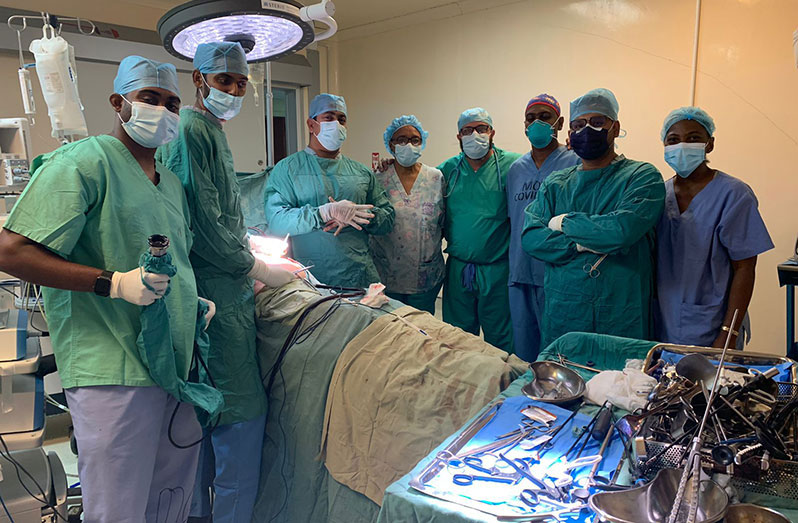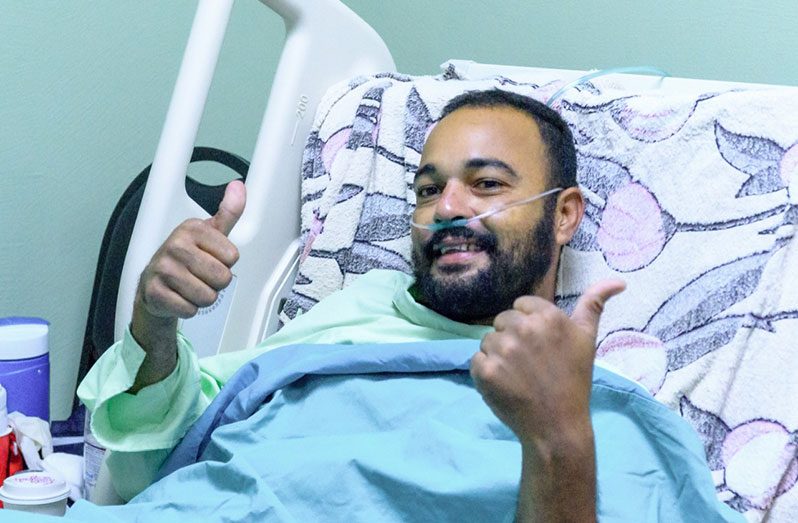— GPHC patients grateful for life after groundbreaking surgeries
“I CONSIDER myself the most luckiest person in Guyana at the moment and those doctors are my superheroes,” is how 36-year-old farmer, Christopher James, described his experience after recently receiving lifesaving surgery at the Georgetown Public Hospital Corporation (GPHC).
Fifty-four year-old nursing assistant, Yourajpatti Stanwick, also could not stop singing praises of doctors at the GPHC, who not only performed lifesaving surgery on her, but by performing Guyana’s first laparoscopic adrenalectomy, drastically cut down her recovery time for which she is profusely grateful.
“I can’t find enough words to thank them. I was so impressed, they were exceptionally great. The care was just so, so good. I would advise anyone [to do it], it’s so safe and we have to trust in ourselves,” the mother of two commented in an interview with the Guyana Chronicle on Thursday, one week after her surgery.

James and Stanwick are two of three patients, who all received groundbreaking, lifesaving surgery at the GPHC on November 25. James received surgery for a “ruptured Abdominal Aortic Aneurysm (AAA) and emergency graft repair” while Stanwick received a laparoscopic adrenalectomy, and a “gallbladder cancer cholecystectomy, and hepatectomy” was performed on a 50-year-old female with a history of ovarian cancer.
For James, his recovery has been considered a major milestone for the hospital given that while AAA surgeries have been performed in Guyana in the past, this is the first case of a patient surviving after a ruptured AAA.
Suffering with a history of kidney stones, James had initially thought a pain in his lower abdomen that developed last month was returning kidney stones. However, as the pain got worse he knew it was more, and initially checked into the Mahaicony Hospital before being transferred to the GPHC. At the GPHC, two CT scans confirmed his worst fear; his pain was coming from something much worse than kidney stones. James had an aneurysm, a ballooning of a blood vessel. In this case the aneurysm was in James’ abdominal aorta, a main artery that if ruptured, could kill James in less than an hour.
“They tell me that this thing is serious and we need to get it out immediately. It’s a ticking time bomb. In the space of a couple hours, this thing started to get more and more painful so bad pain I can’t bear it,” James described as he spoke with members of the media on Thursday from his hospital bed at the GPHC where he is still recovering.
Realising the seriousness of the situation, doctors rushed James into emergency surgery but even that was not fast enough with the aneurysm rupturing even as James was being transported to the operating room.
THANK GOD
“It ruptured and my body started to shut down, I couldn’t do anything else. But thank God for the great doctors that Guyana produced that saved my life that I can be here today,” James expressed.
James’ ruptured AAA and emergency graft repair was performed by Dr. Kishore Persaud and Dr. Carlos Martin. Speaking with the Guyana Chronicle, Dr. Kishore credited the quick and aggressive action of the operating team in leading to James being able to be alive today.
“The risk of death was more than 95 per cent. The anesthesia team was very aggressive in resuscitating the patient. When a patient ruptures an aneurysm while in shock on the operating table every minute his mortality increases by one per cent, and he was in shock for more than half an hour while on the OR table. He had a very slim chance of surviving, and that’s a testimony to the effectiveness of what we did,” Dr. Kishore commented.

Pulled from the clutches of death and now recovering in the male ward of the GPHC, James is expected to be able to go home within the next week or so and return to his normal life. But according to James, having come back from the brink of death, his life will never be the same.
Meanwhile, Stanwick’s surgery marked another milestone for the hospital in being the first ever adrenalectomy to be performed laparoscopically.
An adrenalectomy is a surgery to remove the adrenal gland which is found on top of the kidneys while laparoscopic surgery is a minimally invasive surgery, whereby notably smaller cuts are made and the doctor conducts the surgery via inserted cameras, as opposed to “open surgery”, where a surgeon makes incisions six – 12 inches long in order to access organs.
Aside from having smaller incisions, advantages from doing a surgery laparoscopically include reduced blood loss, reduced pain to patient, and shorter hospital stays.
Because her adrenalectomy was done laparoscopically, Stanwick was able to be discharged from the hospital within four days after her surgery.
INITIALLY TERRIFIED
Stanwick, who is from Caneville, Berbice, admitted that she was initially terrified at the idea of being the first patient for a new procedure to be performed on, but now enjoying the post-surgery benefits, she has become an advocate and hopes that laparoscopic surgeries become even more widespread.
“I said to myself I don’t want to be the guinea pig — all that came to my mind. But when I woke up the next morning [after surgery] and I wasn’t feeling anything, I was smiling so much. I felt so comfortable with no pain and I was just smiling. Then the next thing I know I got discharged the following Monday, I just couldn’t believe it,” Stanwick commented.
Having done two other open surgeries in the past, Stanwick personally understood the vast differences and benefits between open and laparoscopic surgeries.
Though her doctor has advised her to wait at least two weeks post-surgery before returning to work, Stanwick cannot stop beaming about her ability to go on with her life normally just a few days after major abdominal surgery. She is all the more happies that it was done at a public hospital and did not put a financial strain on her.
SATISFIED
“When I came home even my neighbours were saying are you sure you did surgery you look so good. What I’m so satisfied about is that it didn’t cost me anything, all it cost me was transportation and food while I was in Georgetown,” she shared.
Stanwick’s adrenalectomy was due to a pheochromocytoma, a tumor that had developed in her adrenal gland. The tumor was detected earlier this year due to high blood pressure that she was experiencing due to the tumor.
Stanwick’s adrenalectomy was performed by a team of surgeons led by General and Advanced Laparoscopic Surgeon, Dr. Heimraj Ramcharran and also included Dr. Tamesh Algu, who was Stanwick’s doctor in Berbice. Dr. Ramcharran hailed the occasion of Guyana’s first laparoscopic adrenalectomy a momentous one.
Dr. Ramcharran was trained in laparoscopic surgery during a fellowship in Canada and now looks forward to training other Guyanese doctors in this area.
During a press conference held at the GPHC on Thursday, Dr. Ramcharran noted that 16 local public doctors have already been undergoing the training to make this modernised technique more widespread across Guyana’s public healthcare system.
Though laparoscopic surgeries have been performed in Guyana in the past, Stanwick’s surgery marks the first time laparoscopic surgery of such an extensive nature was performed here in Guyana.
On the surgical team, Dr. Ramcharran was assisted by Dr. Tamesh Algu, Dr. Leon Placeras, Dr. Delon Ramnarine, Dr. Drohinauth Singh and Dr. Kevon Tracy while on the anaesthesiology team were Dr. Arturo Marrero, Dr. Yvette Martin, Dr. Rhina Acousta and Dr. Fernando.
Dr. Ramcharran particularly praised the work of Dr. Yaquelin Gonzalez-Ricardo, who played a vital role in stabilising the patient’s blood pressure to a level necessary for surgery. The patient’s blood pressure was excessively high, due to the tumor in her adrenal gland.




.png)









